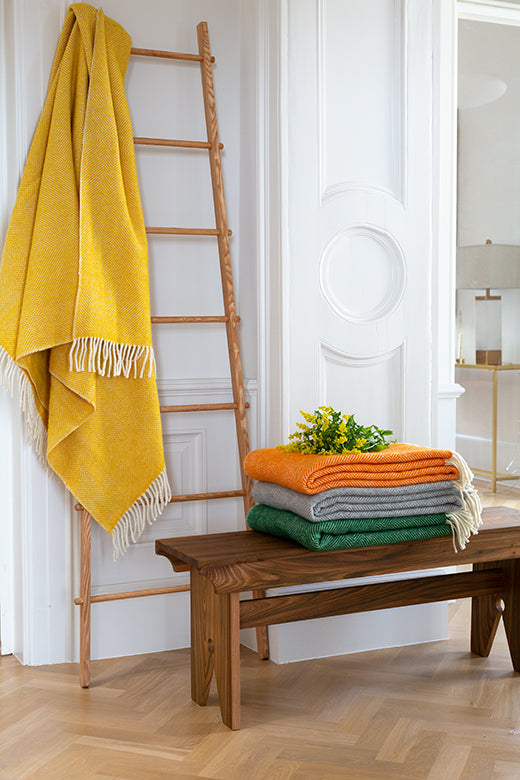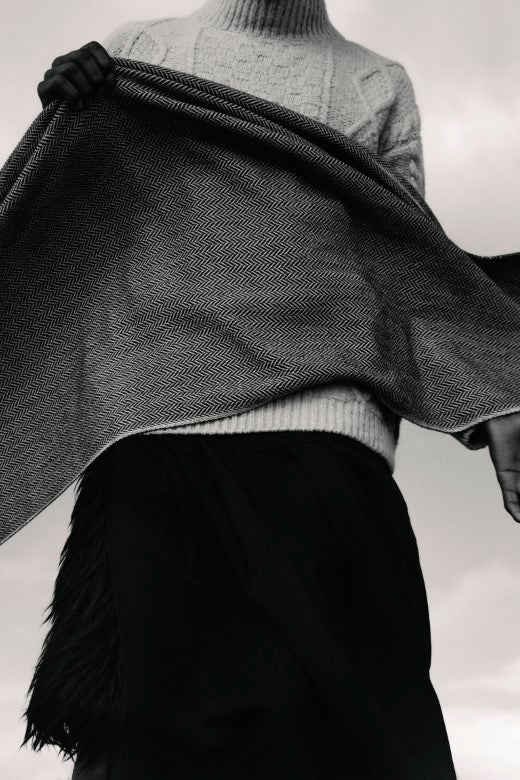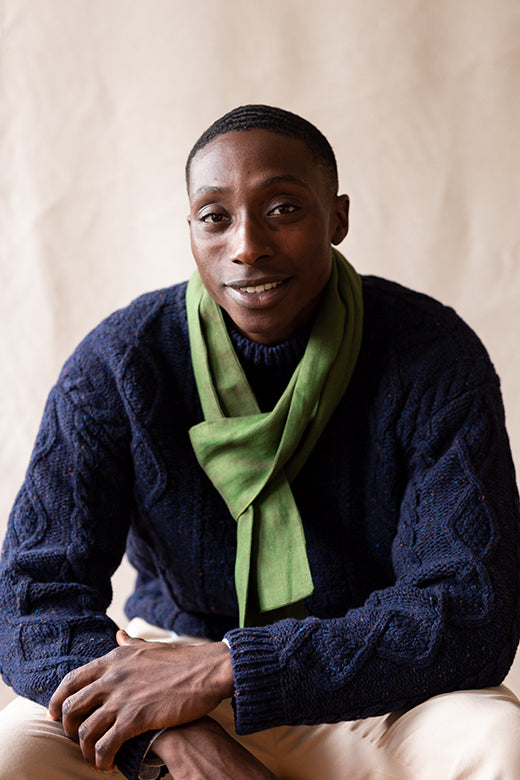Journal
Subheading
Celebrating Saint Brigid on the 1st of February
St Brigid is one of 3 Irish patron saints and was quite a woman in her day. Now we celebrate her for the first time this year as a national holiday!
In our photo here we have hand made st Brigid Crosses made for us by Pauline (who weaves all our beautiful wicker baskets), woven with willow. The traditional custom was to hang the cross inside your house to offer protection for the home and all who lived within.
This is a wonderfully informative piece on the background to st Brigid we found on the website for St. Brigid’s School in Glasnevin in Dublin and gives a rich description of her background and life.
The story of St. Brigid
St. Brigid was born in AD 450 in Faughart, near Dundalk in Co. Louth. Her father, Dubhthach, was a pagan chieftain of Leinster and her mother, Broicsech, was a Christian. It was thought that Brigid’s mother was born in Portugal but was kidnapped by Irish pirates and brought to Ireland to work as a slave, just like St. Patrick was. Brigid’s father named her after one of the most powerful goddesses of the pagan religion - the goddess of fire, whose manifestations were song, craftsmanship, and poetry, which the Irish considered the flame of knowledge. He kept Brigid and her mother as slaves even though he was a wealthy man. Brigid spent her earlier life cooking, cleaning, washing and feeding the animals on her father’s farm.
She lived during the time of St.Patrick and was inspired by his preachings and she became a Christian. When Brigid turned eighteen, she stopped working for her father. Brigid’s father wanted her to find a husband but Brigid had decided that she would spend her life working for God by looking after poor, sick and elderly people. Legend says that she prayed that her beauty would be taken away from her so no one would seek her hand in marriage; her prayer was granted. Brigid’s charity angered her father because he thought she was being too generous to the poor. When she finally gave away his jewel-encrusted sword to a leper, her father realised that she would be best suited to the religious life. Brigid finally got her wish and entered the convent. She received her veil from St. Macaille and made her vows to dedicate her life to God.
Legend also says that Brigid regained her beauty after making her vows and that God made her more beautiful than ever. News of Brigid’s good works spread and soon many young girls from all over the country joined her in the convent. Brigid founded many convents all over Ireland; the most famous one was in Co. Kildare. It is said that this convent was built beside an oak tree where the town of Kildare now stands. Around 470 she also founded a double monastery, for nuns and monks, in Kildare. As Abbess of this foundation she wielded considerable power, but was a very wise and prudent superior. The Abbey of Kildare became one of the most prestigious monasteries in Ireland, and was famous throughout Christian Europe.
St. Brigid also founded a school of art, including metal work and illumination, over which St. Conleth presided. In the scriptorium of the monastery, the famous illuminated manuscript the Book of Kildare was created.
St. Brigid's Cross: Making a St. Brigid’s cross is one of the traditional rituals in Ireland to celebrate the beginning of early spring, 1st February. The crosses are made of rushes that are pulled rather than cut. They are hung by the door and in the rafters to protect the house from fire and evil. According to tradition a new cross is made each St Brigid's Day, and the old one is burned to keep fire from the house. Many homes have several crosses preserved in the ceiling the oldest blackened by many years of hearth fires. Some believe that keeping a cross in the ceiling or roof is a good way to preserve the home from fire which was always a major threat in houses with thatch and wood roofs. St. Brigid and her cross are linked together by the story that she wove this form of cross at the death bed of either her father or a pagan lord, who upon hearing what the cross meant, asked to be baptised.
One version goes as follows: “A pagan chieftain from the neighbourhood of Kildare was dying. Christians in his household sent for Brigid to talk to him about Christ. When she arrived the chieftain was raving. As it was impossible to instruct this delirious man, hopes for his conversion seemed doubtful. Brigid sat down at his bedside and began consoling him. As was customary, the dirt floor was strewn with rushes both for warmth and cleanliness. Brigid stooped down and started to weave them into a cross, fastening the points together. The sick man asked what she was doing. She began to explain the cross, and as she talked his delirium quieted and he questioned her with growing interest. Through her weaving, he converted and was baptised at the point of death. Since then the cross of rushes has been venerated in Ireland.”
St. Brigid died in AD 525 at the age of 75 and was buried in a tomb before the High Altar of her Abbey church. After some time, her remains were exhumed and transferred to Downpatrick to rest with the two other patron saints of Ireland, St. Patrick and St. Columcille. Her skull was extracted and brought to Lisbon, Portugal by two Irish noblemen, and it remains there to this day St. Brigid is the female patron saint of Ireland. She is also known as Muire na nGael or Mary of the Gael which means Our Lady of the Irish. Her feast day is the 1st of February which is the first day of Spring in Ireland.
St. Brigid's Cloak: St. Brigid went to the King of Leinster to ask for land to build a convent. She told the king that the place where she stood was the perfect place for a convent. It was beside a forest where they could collect firewood. There was also a lake nearby that would provide water and the land was fertile. The king laughed at her and refused to give her any land. Brigid prayed to God and asked him to soften the king’s heart. Then she smiled at the king and said “will you give me as much land as my cloak will cover?” The king thought that she was joking and because Brigid’s cloak was so small he knew that it would only cover a very small piece of land.
The king agreed and Brigid spread her cloak on the ground. She asked her four friends to hold a corner of the cloak and walk in opposite directions. The four friends walked north, south, east and west. The cloak grew immediately and began to cover many acres of land. The king was astonished and he realized that she had been blessed by God. The king fell to the ground and knelt before Brigid and promised her and her friends money, food and supplies. Soon afterwards, the king became a Christian and also started to help the poor. Brigid’s miracle of the cloak was the first of many miracles that she worked for the people of Ireland.
See here also for a link to an interesting video by the National Museum of Ireland about the history of the St Brigid Cross
https://www.museum.ie/en-IE/News/St-Brigids-Day
In our photo here we have hand made st Brigid Crosses made for us by Pauline (who weaves all our beautiful wicker baskets), woven with willow. The traditional custom was to hang the cross inside your house to offer protection for the home and all who lived within.
This is a wonderfully informative piece on the background to st Brigid we found on the website for St. Brigid’s School in Glasnevin in Dublin and gives a rich description of her background and life.
The story of St. Brigid
St. Brigid was born in AD 450 in Faughart, near Dundalk in Co. Louth. Her father, Dubhthach, was a pagan chieftain of Leinster and her mother, Broicsech, was a Christian. It was thought that Brigid’s mother was born in Portugal but was kidnapped by Irish pirates and brought to Ireland to work as a slave, just like St. Patrick was. Brigid’s father named her after one of the most powerful goddesses of the pagan religion - the goddess of fire, whose manifestations were song, craftsmanship, and poetry, which the Irish considered the flame of knowledge. He kept Brigid and her mother as slaves even though he was a wealthy man. Brigid spent her earlier life cooking, cleaning, washing and feeding the animals on her father’s farm.
She lived during the time of St.Patrick and was inspired by his preachings and she became a Christian. When Brigid turned eighteen, she stopped working for her father. Brigid’s father wanted her to find a husband but Brigid had decided that she would spend her life working for God by looking after poor, sick and elderly people. Legend says that she prayed that her beauty would be taken away from her so no one would seek her hand in marriage; her prayer was granted. Brigid’s charity angered her father because he thought she was being too generous to the poor. When she finally gave away his jewel-encrusted sword to a leper, her father realised that she would be best suited to the religious life. Brigid finally got her wish and entered the convent. She received her veil from St. Macaille and made her vows to dedicate her life to God.
Legend also says that Brigid regained her beauty after making her vows and that God made her more beautiful than ever. News of Brigid’s good works spread and soon many young girls from all over the country joined her in the convent. Brigid founded many convents all over Ireland; the most famous one was in Co. Kildare. It is said that this convent was built beside an oak tree where the town of Kildare now stands. Around 470 she also founded a double monastery, for nuns and monks, in Kildare. As Abbess of this foundation she wielded considerable power, but was a very wise and prudent superior. The Abbey of Kildare became one of the most prestigious monasteries in Ireland, and was famous throughout Christian Europe.
St. Brigid also founded a school of art, including metal work and illumination, over which St. Conleth presided. In the scriptorium of the monastery, the famous illuminated manuscript the Book of Kildare was created.
St. Brigid's Cross: Making a St. Brigid’s cross is one of the traditional rituals in Ireland to celebrate the beginning of early spring, 1st February. The crosses are made of rushes that are pulled rather than cut. They are hung by the door and in the rafters to protect the house from fire and evil. According to tradition a new cross is made each St Brigid's Day, and the old one is burned to keep fire from the house. Many homes have several crosses preserved in the ceiling the oldest blackened by many years of hearth fires. Some believe that keeping a cross in the ceiling or roof is a good way to preserve the home from fire which was always a major threat in houses with thatch and wood roofs. St. Brigid and her cross are linked together by the story that she wove this form of cross at the death bed of either her father or a pagan lord, who upon hearing what the cross meant, asked to be baptised.
One version goes as follows: “A pagan chieftain from the neighbourhood of Kildare was dying. Christians in his household sent for Brigid to talk to him about Christ. When she arrived the chieftain was raving. As it was impossible to instruct this delirious man, hopes for his conversion seemed doubtful. Brigid sat down at his bedside and began consoling him. As was customary, the dirt floor was strewn with rushes both for warmth and cleanliness. Brigid stooped down and started to weave them into a cross, fastening the points together. The sick man asked what she was doing. She began to explain the cross, and as she talked his delirium quieted and he questioned her with growing interest. Through her weaving, he converted and was baptised at the point of death. Since then the cross of rushes has been venerated in Ireland.”
St. Brigid died in AD 525 at the age of 75 and was buried in a tomb before the High Altar of her Abbey church. After some time, her remains were exhumed and transferred to Downpatrick to rest with the two other patron saints of Ireland, St. Patrick and St. Columcille. Her skull was extracted and brought to Lisbon, Portugal by two Irish noblemen, and it remains there to this day St. Brigid is the female patron saint of Ireland. She is also known as Muire na nGael or Mary of the Gael which means Our Lady of the Irish. Her feast day is the 1st of February which is the first day of Spring in Ireland.
St. Brigid's Cloak: St. Brigid went to the King of Leinster to ask for land to build a convent. She told the king that the place where she stood was the perfect place for a convent. It was beside a forest where they could collect firewood. There was also a lake nearby that would provide water and the land was fertile. The king laughed at her and refused to give her any land. Brigid prayed to God and asked him to soften the king’s heart. Then she smiled at the king and said “will you give me as much land as my cloak will cover?” The king thought that she was joking and because Brigid’s cloak was so small he knew that it would only cover a very small piece of land.
The king agreed and Brigid spread her cloak on the ground. She asked her four friends to hold a corner of the cloak and walk in opposite directions. The four friends walked north, south, east and west. The cloak grew immediately and began to cover many acres of land. The king was astonished and he realized that she had been blessed by God. The king fell to the ground and knelt before Brigid and promised her and her friends money, food and supplies. Soon afterwards, the king became a Christian and also started to help the poor. Brigid’s miracle of the cloak was the first of many miracles that she worked for the people of Ireland.
See here also for a link to an interesting video by the National Museum of Ireland about the history of the St Brigid Cross
https://www.museum.ie/en-IE/News/St-Brigids-Day










